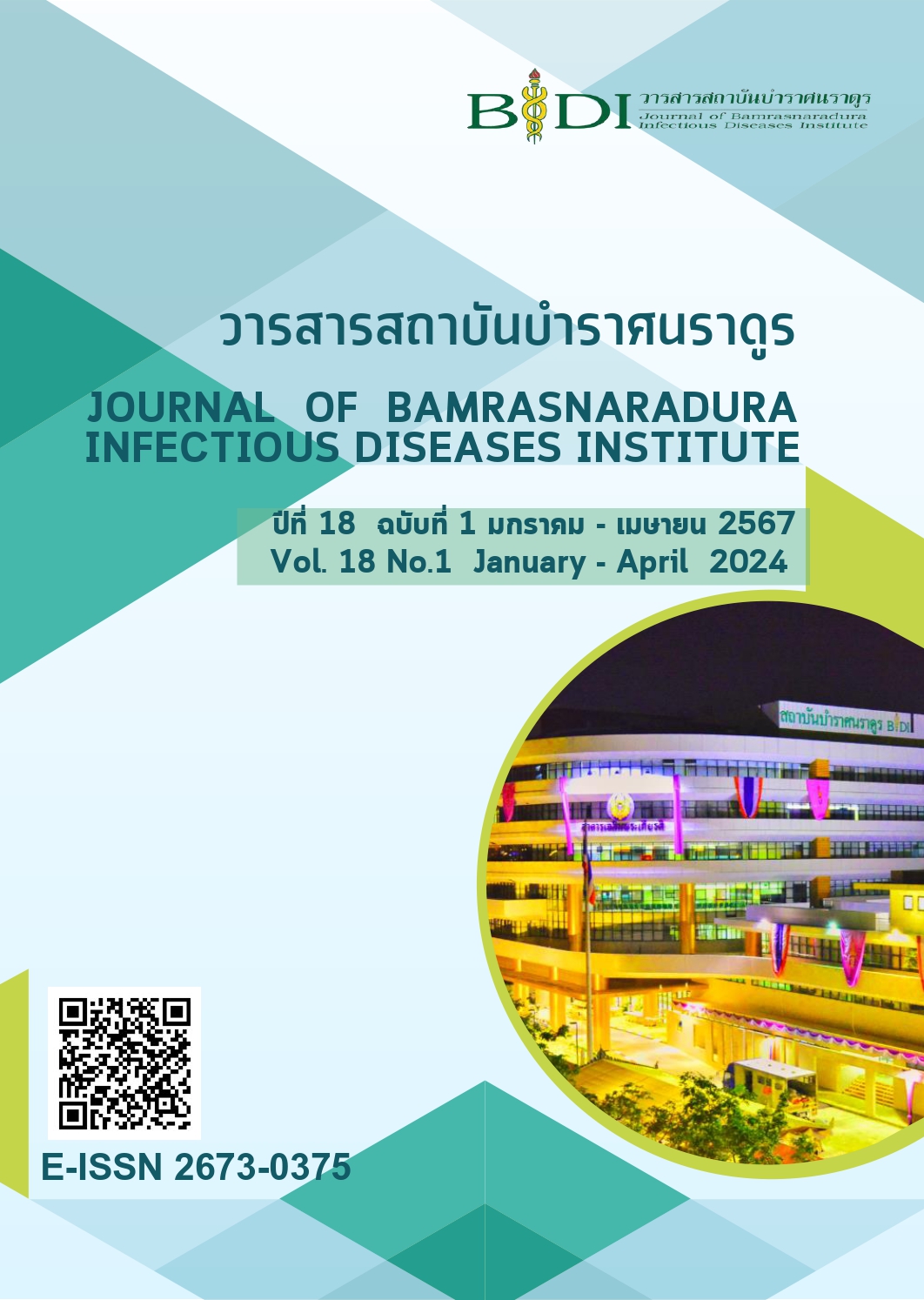อัตราการปนเปื้อนการเพาะเชื้อปัสสาวะ และปัจจัยที่เกี่ยวข้อง ในโรงพยาบาลมหาวิทยาลัยในภาคใต้
Main Article Content
บทคัดย่อ
การศึกษานี้เป็นการวิจัยเชิงวิเคราะห์ภาคตัดขวางเพื่อศึกษาอัตราการปนเปื้อนและปัจจัยที่เกี่ยวข้องกับการปนเปื้อนการเพาะเชื้อปัสสาวะของกลุ่มผู้ป่วยที่ได้รับการเพาะเชื้อปัสสาวะในโรงพยาบาลสงขลานครินทร์ ด้วยการถ่ายปัสสาวะปกติ และการเก็บด้วยการสวนท่อปัสสาวะ ซึ่งเป็นผู้ที่มีอายุตั้งแต่ 2 ปีขึ้นไป ระหว่างเดือนมกราคม-ธันวาคม 2562 จำนวน 6,555 คน โดยเก็บรวบรวมข้อมูลจากระบบเวชระเบียน วิเคราะห์โดยใช้สถิติเชิงพรรณนา การทดสอบไคสแควร์ และการวิเคราะห์ถดถอยโลจิสติคแบบพหุคูณ
ผลการศึกษาพบว่า ประชากรส่วนใหญ่มีอายุในช่วง 60-79 ปี (ร้อยละ 34.08) และเป็นเพศหญิง (ร้อยละ 60.54) พบอัตราการปนเปื้อนของการเพาะเชื้อปัสสาวะคิดเป็นร้อยละ 5.71 โดยปัจจัยที่เพิ่มการปนเปื้อนของผลเพาะเชื้อปัสสาวะ ได้แก่ ผู้ป่วยเพศหญิง (OR = 1.29, 95% CI = 1.03-1.61) ผู้ที่อยู่ในช่วงอายุ 20-79 ปี (OR = 2.02-2.52) และค่าดัชนีมวลกายที่มากกว่าหรือเท่ากับ 30 กก./ตร.ม. (OR = 1.74, 95% CI = 1.08-2.81) สำหรับการส่งตรวจจากห้องฉุกเฉิน เป็นปัจจัยที่ช่วยลดการปนเปื้อนการเพาะเชื้อปัสสาวะ (OR = 0.61, 95% CI = 0.47-0.78)
การวิจัยนี้แสดงให้เห็นถึงอัตราการปนเปื้อนและปัจจัยที่เพิ่มหรือลดการปนเปื้อนในการส่งเพาะเชื้อ ปัสสาวะ ซึ่งทำให้ทราบว่าในกระบวนการเก็บปัสสาวะเพื่อส่งตรวจเพาะเชื้อกับผู้ป่วยเพศหญิง ผู้ที่มีอายุในช่วง 20-79 ปี และผู้ที่มีโรคอ้วน เป็นกลุ่มที่ควรได้รับคำแนะนำอย่างระมัดระวัง รวมถึงควรปรับปรุงระบบการส่ง ปัสสาวะ ไปยังห้องปฏิบัติการให้รวดเร็วขึ้นทั้งโรงพยาบาล เหมือนกับระบบของห้องฉุกเฉินเพื่อให้สามารถลดอัตราการปนเปื้อนลงได้
Article Details
เอกสารอ้างอิง
Foxman B. The epidemiology of urinary tract infection. Nat Rev Urol 2010; 7(12): 653-60.
Hooton TM, Roberts PL, Cox ME, Stapleton AE. Voided midstream urine culture and acute cystitis in premenopausal women. N Engl J Med 2013; 369(20): 1883-91.
Czajkowski K, Brosś-Konopielko M, Teliga-Czajkowska J. Urinary tract infection in women. Prz Menopauzalny 2021; 20(1): 40-7.
Kranz J, Schmidt S, Wagenlehner F, Schneidewind L. Catheter-Associated Urinary Tract Infections in Adult Patients. Dtsch Arztebl Int 2020; 117(6): 83-8.
Leung AKC, Wong AHC, Leung AAM, Hon KL. Urinary Tract Infection in Children. Recent Pat Inflamm Allergy Drug Discov 2019; 13(1): 2-18.
Dubbs SB, Sommerkamp SK. Evaluation and Management of Urinary Tract Infection in the Emergency Department. Emerg Med Clin North Am 2019; 37(4): 707-23.
Sabih A, Leslie SW. Complicated Urinary Tract Infections. In: StatPearls. Treasure Island (FL): StatPearls Publishing; 2022.
Ness D, Olsburgh J. UTI in kidney transplant. World J Urol 2020; 38(1): 81-8.
Ghouri F, Hollywood A, Ryan K. A systematic review of non-antibiotic measures for the prevention of urinary tract infections in pregnancy. BMC Pregnancy Childbirth 2018 Apr 13; 18(1): 99.
Azami M, Jaafari Z, Masoumi M, Shohani M, Badfar G, Mahmudi L, et al. The etiology and prevalence of urinary tract infection and asymptomatic bacteriuria in pregnant women in Iran: a systematic review and Meta-analysis. BMC Urol 2019; 19(1): 43.
Yuan S, Shi Y, Li M, Hu X, Bai R. Trends in Incidence of Urinary Tract Infection in Mainland China from 1990 to 2019. Int J Gen Med 2021; 14: 1413-20.
Chu CM, Lowder JL. Diagnosis and treatment of urinary tract infections across age groups. Am J Obstet Gynecol 2018; 219(1): 40-51.
Bekeris LG, Jones BA, Walsh MK, Wagar EA. Urine culture contamination: a College of American Pathologists Q-Probes study of 127 laboratories. Arch Pathol Lab Med 2008;1 32(6): 913-7.
Flores-Mireles AL, Walker JN, Caparon M, Hultgren SJ. Urinary tract infections: epidemiology, mechanisms of infection and treatment options. Nat Rev Microbiol 2015; 13(5): 269-84.
Klausing BT, Tillman SD, Wright PW, Talbot TR. The influence of contaminated urine cultures in inpatient and emergency department settings. Am J Infect Control 2016; 44(10): 1166-7.
Iregbu KC MN, Abdullahi N, Aigbe A, Modibbo I, Nwajiobi-Princewill P. Urine culture contamination: a one-year retrospective study at the national hospital, abuja. African J Clin Exp Microbiol 2013; 14: 101-4.
Lifshitz E, Kramer L. Outpatient urine culture: does collection technique matter? Arch Intern Med 2000; 160(16): 2537-40.
Shamsundar, Prashanth. Urine Culture Contamination: A One-Year Retrospective Study at the Tertiary Care Hospital. J Evol Med Dent Sci 2014; 3(74): 3.
Soriano A, Sansone S, Arora E, Arya L, Andy U. Risk of Contamination of Voided Urine Specimen in Women With Pelvic Organ Prolapse. Female Pelvic Med Reconstr Surg. 2020; 26(8): 488-92.
Sangsuwan T, Jariyasoonthornkit K, Jamulitrat S. Antimicrobial Resistance Patterns Amid Community-Acquired Uropathogens in Outpatient Settings of a Tertiary Care Hospital in Thailand. Siriraj Med J. 2021; 73(8): 501-9.
Odoki M, Almustapha Aliero A, Tibyangye J, Nyabayo Maniga J, Wampande E, Drago Kato C, et al. Prevalence of Bacterial Urinary Tract Infections and Associated Factors among Patients Attending Hospitals in Bushenyi District, Uganda. Int J Microbiol 2019; 2019: 1-8.
Akepalakorn W. Thai National Health Examination Survey [internet]. 2014. (cited 2019 December 5); Available from: https://kb.hsri.or.th/dspace/handle/11228/2976?locale-attribute=th (In Thai)
Moue A, Aktaruzzaman SM, Ferdous N, Karim MR, Khalil MM, Das AK, editors. Prevalence Of Urinary Tract Infection In Both Outpatient Department And In Patient Department At A Medical College Setting Of Bangladesh 2015; 7(5): 146-152.
Shrestha R, Gyawali N, Gurung R, Amatya R, Bhattacharya SK. Effect Of Urogenital Cleaning With Paper Soap On Bacterial Contamination Rate While Collecting Midstream Urine Specimens. J Lab Physicians 2013; 5(1): 17-20.
Gopal GK, Wilson BP, Viggeswarpu S, Sathyendra S, Iyyadurai R, Visvanathan R, et al. Clinical Profile and Predictors of Outcomes in Older Inpatients with Pyelonephritis in a Tertiary Care Hospital in Southern India. J Clin Diagn Res 2015; 9(10): OC05-OC7.
Zwank M, Bourdon R. Risk of a Contaminated Urine Specimen Linked to High BMI. J Fam Pract 2016; 65(2): 84-139.
Strawn M, Xu KT, Brodeur M, Youngblood G, Richman P. A Prospective Study to Assess the Association of Body Mass Index and Contamination of Urinalysis Samples. Am J Emerg Med 2020; 38(3): 508-11.
Alex S, Sansone S, Arora E, Arya L, Andy U. Risk of Contamination of Voided Urine Specimen in Women with Pelvic Organ Prolapse. Female Pelvic Med Reconstr Surg 2020; 26: 488–92.


